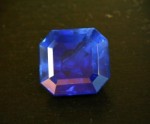
Lately, we’ve spotted a host of A-List celebrities — including Scarlett Johansson, Nicole Richie , Natalie Portman and Jennifer Lopez — wearing ruby rings on the Red Carpet. There’s no denying that the ruby ring is surging back into vogue just in time for spring, and the ruby options on the jewelry market are endless. But take it from the gem experts at Diamond & Estate Trust : although it can be difficult to find, a no-heat ruby is by far the most exquisite choice. Rubies have long been considered royal gems, both for their mythical healing properties and central role in the jewelry of some of history’s most famous nobility . When you’re looking to buy a ruby ring , the most important quality to consider is whether the ruby has been treated. Most low-value rubies on the market have been artificially heat-treated to improve color, usually by removing blue or purple hues. These rubies are the ones to avoid, as their value and beauty are both low-quality. A no-heat ruby – one with a naturally coveted hue not achieved through a treatment process – is truly an exquisite gem with unparalleled natural beauty. Why purchase something artificial when the natural version is much more gorgeous, rare and coveted? This 5.09 carat Burma no-heat ruby ring from the Diamond & Estate Trust collection is the epitome of modern luxury. The rich, full red color and slight blue tint make the Burma ruby highly coveted throughout the world, and this stunning, no-heat 5.09 carat ruby boasts all those exceptional qualities. This massive oval Burma ruby has a natural color and clean facets that make it shine vividly under any light. The white diamonds that surround the ruby are as delicate and chic as this ring’s modern platinum setting. It’s a vivid, lively ring that is just as vogue today as when it was handcrafted. And because this Burma ruby is a certified no-heat gem, you can be sure that it is of the highest quality imaginable. With an exquisite collection of luxury gems such as diamonds , colored diamonds , no-heat rubies and no-heat sapphires , Diamond & Estate Trust is Southern California’s premier luxury jewelry buyer and seller. We hand-pick each gem and piece of vintage jewelry in our collection based on quality, design and natural beauty. Link: No-Heat Ruby – 5.09 Carat Burma Ruby Ring




